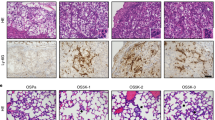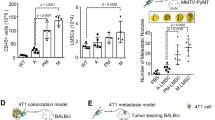Abstract
The mechanism by which renal cell carcinoma (RCC) colonizes the lung microenvironment during metastasis remains largely unknown. To investigate this process, we grafted human RCC cells with varying lung metastatic potential in mice. Gene expression profiling of the mouse lung stromal compartment revealed a signature enriched for neutrophil-specific functions that was induced preferentially by poorly metastatic cells. Analysis of the gene expression signatures of tumor cell lines showed an inverse correlation between metastatic activity and the levels of a number of chemokines, including CXCL5 and IL8. Enforced depletion of CXCL5 and IL8 in these cell lines enabled us to establish a functional link between lung neutrophil infiltration, secretion of chemokines by cancer cells and metastatic activity. We further show that human neutrophils display a higher cytotoxic activity against poorly metastatic cells compared with highly metastatic cells. Together, these results support a model in which neutrophils recruited to the lung by tumor-secreted chemokines build an antimetastatic barrier with loss of neutrophil chemokines in tumor cells acting as a critical rate-limiting step during lung metastatic seeding.
This is a preview of subscription content, access via your institution
Access options
Subscribe to this journal
Receive 50 print issues and online access
$259.00 per year
only $5.18 per issue
Buy this article
- Purchase on Springer Link
- Instant access to full article PDF
Prices may be subject to local taxes which are calculated during checkout





Similar content being viewed by others
References
Cohen HT, McGovern FJ . Renal-cell carcinoma. N Engl J Med 2005; 353: 2477–2490.
Motzer RJ, Hutson TE, Tomczak P, Michaelson MD, Bukowski RM, Rixe O et al. Sunitinib versus interferon alfa in metastatic renal-cell carcinoma. N Engl J Med 2007; 356: 115–124.
McAllister SS, Weinberg RA . Tumor-host interactions: a far-reaching relationship. J Clin Oncol 2010; 28: 4022–4028.
Joyce JA, Pollard JW . Microenvironmental regulation of metastasis. Nat Rev Cancer 2009; 9: 239–252.
Allinen M, Beroukhim R, Cai L, Brennan C, Lahti-Domenici J, Huang H et al. Molecular characterization of the tumor microenvironment in breast cancer. Cancer Cell 2004; 6: 17–32.
Chang HY, Sneddon JB, Alizadeh AA, Sood R, West RB, Montgomery K et al. Gene expression signature of fibroblast serum response predicts human cancer progression: similarities between tumors and wounds. PLoS Biol 2004; 2: E7.
de Visser KE, Eichten A, Coussens LM . Paradoxical roles of the immune system during cancer development. Nat Rev Cancer 2006; 6: 24–37.
Mantovani A, Sica A . Macrophages, innate immunity and cancer: balance, tolerance, and diversity. Curr Opin Immunol 2010; 22: 231–237.
Talmadge JE, Donkor M, Scholar E . Inflammatory cell infiltration of tumors: Jekyll or Hyde. Cancer Metastasis Rev 2007; 26: 373–400.
Ostrand-Rosenberg S . Immune surveillance: a balance between protumor and antitumor immunity. Curr Opin Genet Dev 2008; 18: 11–18.
Fridlender ZG, Sun J, Kim S, Kapoor V, Cheng G, Ling L et al. Polarization of tumor-associated neutrophil phenotype by TGF-beta: “N1” versus “N2” TAN. Cancer Cell 2009; 16: 183–194.
Murdoch C, Muthana M, Coffelt SB, Lewis CE . The role of myeloid cells in the promotion of tumour angiogenesis. Nat Rev Cancer 2008; 8: 618–631.
Paget S . The distribution of secondary growths in cancer of the breast. 1889. Cancer Metastasis Rev 1989; 8: 98–101.
Fidler IJ . The pathogenesis of cancer metastasis: the ‘seed and soil’ hypothesis revisited. Nat Rev Cancer 2003; 3: 453–458.
Nguyen DX, Massague J . Genetic determinants of cancer metastasis. Nat Rev Genet 2007; 8: 341–352.
Kaplan RN, Riba RD, Zacharoulis S, Bramley AH, Vincent L, Costa C et al. VEGFR1-positive haematopoietic bone marrow progenitors initiate the pre-metastatic niche. Nature 2005; 438: 820–827.
Lopez-Lago MA, Thodima VJ, Guttapalli A, Chan TA, Heguy A, Molina AM et al. Genomic Deregulation during Metastasis of Renal Cell Carcinoma Implements a Myofibroblast-Like Program of Gene Expression. Cancer Res 2010.
Naito S, Walker SM, Fidler IJ . In vivo selection of human renal cell carcinoma cells with high metastatic potential in nude mice. Clin Exp Metastasis 1989; 7: 381–389.
Su AI, Wiltshire T, Batalov S, Lapp H, Ching KA, Block D et al. A gene atlas of the mouse and human protein-encoding transcriptomes. Proc Natl Acad Sci USA 2004; 101: 6062–6067.
Ebert T, Bander NH, Finstad CL, Ramsawak RD, Old LJ . Establishment and characterization of human renal cancer and normal kidney cell lines. Cancer Res 1990; 50: 5531–5536.
Tan X, Zhai Y, Chang W, Hou J, He S, Lin L et al. Global analysis of metastasis-associated gene expression in primary cultures from clinical specimens of clear-cell renal-cell carcinoma. Int J Cancer 2008; 123: 1080–1088.
Murphy GP, Hrushesky WJ . A murine renal cell carcinoma. J Natl Cancer Inst 1973; 50: 1013–1025.
Finak G, Sadekova S, Pepin F, Hallett M, Meterissian S, Halwani F et al. Gene expression signatures of morphologically normal breast tissue identify basal-like tumors. Breast Cancer Res 2006; 8: R58.
Dakhova O, Ozen M, Creighton CJ, Li R, Ayala G, Rowley D et al. Global gene expression analysis of reactive stroma in prostate cancer. Clin Cancer Res 2009; 15: 3979–3989.
Jensen HK, Donskov F, Marcussen N, Nordsmark M, Lundbeck F, von der Maase H . Presence of intratumoral neutrophils is an independent prognostic factor in localized renal cell carcinoma. J Clin Oncol 2009; 27: 4709–4717.
Bellocq A, Antoine M, Flahault A, Philippe C, Crestani B, Bernaudin JF et al. Neutrophil alveolitis in bronchioloalveolar carcinoma: induction by tumor-derived interleukin-8 and relation to clinical outcome. Am J Pathol 1998; 152: 83–92.
Foekens JA, Ries C, Look MP, Gippner-Steppert C, Klijn JG, Jochum M . The prognostic value of polymorphonuclear leukocyte elastase in patients with primary breast cancer. Cancer Res 2003; 63: 337–341.
Di Carlo E, Forni G, Lollini P, Colombo MP, Modesti A, Musiani P . The intriguing role of polymorphonuclear neutrophils in antitumor reactions. Blood 2001; 97: 339–345.
Buonocore S, Haddou NO, Moore F, Florquin S, Paulart F, Heirman C et al. Neutrophil-dependent tumor rejection and priming of tumoricidal CD8+ T cell response induced by dendritic cells overexpressing CD95L. J Leukoc Biol 2008; 84: 713–720.
Schaider H, Oka M, Bogenrieder T, Nesbit M, Satyamoorthy K, Berking C et al. Differential response of primary and metastatic melanomas to neutrophils attracted by IL-8. Int J Cancer 2003; 103: 335–343.
Kowanetz M, Wu X, Lee J, Tan M, Hagenbeek T, Qu X et al. Granulocyte-colony stimulating factor promotes lung metastasis through mobilization of Ly6G+Ly6C+ granulocytes. Proc Natl Acad Sci USA. 2010; 107: 21248–21255.
Granot Z, Henke E, Comen EA, King TA, Norton L, Benezra R . Tumor entrained neutrophils inhibit seeding in the premetastatic lung. Cancer Cell [Research Support, N.I.H., Extramural Research Support, Non-U.S. Gov’t] 2011; 20: 300–314.
Balkwill F . Cancer and the chemokine network. Nat Rev Cancer 2004; 4: 540–550.
Monti P, Leone BE, Marchesi F, Balzano G, Zerbi A, Scaltrini F et al. The CC chemokine MCP-1/CCL2 in pancreatic cancer progression: regulation of expression and potential mechanisms of antimalignant activity. Cancer Res 2003; 63: 7451–7461.
Gorbachev AV, Kobayashi H, Kudo D, Tannenbaum CS, Finke JH, Shu S et al. CXC chemokine ligand 9/monokine induced by IFN-gamma production by tumor cells is critical for T cell-mediated suppression of cutaneous tumors. J Immunol 2007; 178: 2278–2286.
Kondo T, Ito F, Nakazawa H, Horita S, Osaka Y, Toma H . High expression of chemokine gene as a favorable prognostic factor in renal cell carcinoma. J Urol 2004; 171: 2171–2175.
Schadendorf D, Moller A, Algermissen B, Worm M, Sticherling M, Czarnetzki BM . IL-8 produced by human malignant melanoma cells in vitro is an essential autocrine growth factor. J Immunol 1993; 151: 2667–2675.
Singh RK, Gutman M, Radinsky R, Bucana CD, Fidler IJ . Expression of interleukin 8 correlates with the metastatic potential of human melanoma cells in nude mice. Cancer Res 1994; 54: 3242–3247.
Arenberg DA, Kunkel SL, Polverini PJ, Glass M, Burdick MD, Strieter RM . Inhibition of interleukin-8 reduces tumorigenesis of human non-small cell lung cancer in SCID mice. J Clin Invest 1996; 97: 2792–2802.
Lee LF, Hellendall RP, Wang Y, Haskill JS, Mukaida N, Matsushima K et al. IL-8 reduced tumorigenicity of human ovarian cancer in vivo due to neutrophil infiltration. J Immunol 2000; 164: 2769–2775.
Takahashi H, Numasaki M, Lotze MT, Sasaki H . Interleukin-17 enhances bFGF-, HGF- and VEGF-induced growth of vascular endothelial cells. Immunol Lett 2005; 98: 189–193.
Arenberg DA, Keane MP, DiGiovine B, Kunkel SL, Morris SB, Xue YY et al. Epithelial-neutrophil activating peptide (ENA-78) is an important angiogenic factor in non-small cell lung cancer. J Clin Invest 1998; 102: 465–472.
Wong YF, Cheung TH, Lo KW, Yim SF, Siu NS, Chan SC et al. Identification of molecular markers and signaling pathway in endometrial cancer in Hong Kong Chinese women by genome-wide gene expression profiling. Oncogene 2007; 26: 1971–1982.
Miyazaki H, Patel V, Wang H, Edmunds RK, Gutkind JS, Yeudall WA . Down-regulation of CXCL5 inhibits squamous carcinogenesis. Cancer Res 2006; 66: 4279–4284.
Speetjens FM, Kuppen PJ, Sandel MH, Menon AG, Burg D, van de Velde CJ et al. Disrupted expression of CXCL5 in colorectal cancer is associated with rapid tumor formation in rats and poor prognosis in patients. Clin Cancer Res 2008; 14: 2276–2284.
Linehan WM, Walther MM, Zbar B . The genetic basis of cancer of the kidney. J Urol 2003; 170: 2163–2172.
Jiang F, Desper R, Papadimitriou CH, Schaffer AA, Kallioniemi OP, Richter J et al. Construction of evolutionary tree models for renal cell carcinoma from comparative genomic hybridization data. Cancer Res 2000; 60: 6503–6509.
Bissig H, Richter J, Desper R, Meier V, Schraml P, Schaffer AA et al. Evaluation of the clonal relationship between primary and metastatic renal cell carcinoma by comparative genomic hybridization. Am J Pathol 1999; 155: 267–274.
Naito S, von Eschenbach AC, Giavazzi R, Fidler IJ . Growth and metastasis of tumor cells isolated from a human renal cell carcinoma implanted into different organs of nude mice. Cancer Res 1986; 46: 4109–4115.
Tusher VG, Tibshirani R, Chu G . Significance analysis of microarrays applied to the ionizing radiation response. Proc Natl Acad Sci USA [Research Support, Non-U.S. Gov’t Research Support, U.S. Gov’t, P.H.S.] 2001; 98: 5116–5121.
Acknowledgements
This study was supported by research grants from the National Cancer Institute (CA-121327), the V-Foundation and a Syms kidney cancer award. We thank Marco Seandel and Eric Pamer for critical reading of the manuscript. The MSKCC Genomics Core Facility provided expert assistance in performing the gene expression profiling assays. R Chaganti is a Board member and a paid consultant of Cancer Genetics Inc., Rutherford, NJ, USA.
Author information
Authors and Affiliations
Corresponding author
Additional information
Supplementary Information accompanies the paper on the Oncogene website
Supplementary information
Rights and permissions
About this article
Cite this article
López-Lago, M., Posner, S., Thodima, V. et al. Neutrophil chemokines secreted by tumor cells mount a lung antimetastatic response during renal cell carcinoma progression. Oncogene 32, 1752–1760 (2013). https://doi.org/10.1038/onc.2012.201
Received:
Revised:
Accepted:
Published:
Issue Date:
DOI: https://doi.org/10.1038/onc.2012.201
Keywords
This article is cited by
-
Tumor-associated neutrophils suppress CD8+ T cell immunity in urothelial bladder carcinoma through the COX-2/PGE2/IDO1 Axis
British Journal of Cancer (2024)
-
SorLA restricts TNFα release from microglia to shape a glioma-supportive brain microenvironment
EMBO Reports (2024)
-
The pro-tumorigenic responses in metastatic niches: an immunological perspective
Clinical and Translational Oncology (2022)
-
Characteristics of pre-metastatic niche: the landscape of molecular and cellular pathways
Molecular Biomedicine (2021)
-
Nicotine promotes breast cancer metastasis by stimulating N2 neutrophils and generating pre-metastatic niche in lung
Nature Communications (2021)



